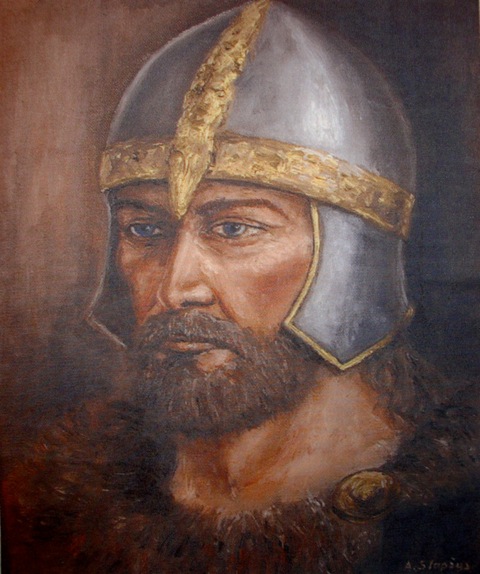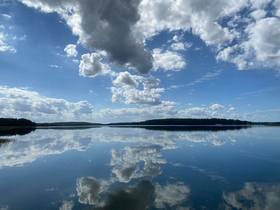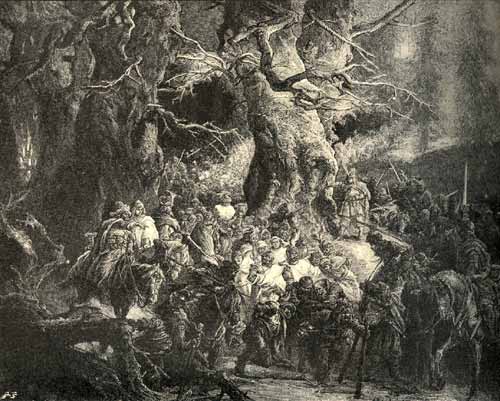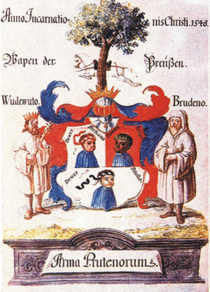
The history of ancient Prusai WHO WERE THE PRUSAI? ARCHEOLOGY COULD PRUSAI BE CHRISTIANS ? Mieszko I Poland THE ARMS AND THE WAY OF FIGHT THE CONQUEST, I, II UPRISING THE III-rd PRUSAI UPRISING The PRUSAI KNIGHTHOOD OPPOSITION What has happened to Prusai? THE GERMANIC ENSLAVEMENTS
The Battle of Grunwald
Culmland Banner The Prusai Maps
PRUSAI
Prusians Heroes Prominent Prusian Where you are, Prusai?
COAT OF ARMS
The Coat of Arms THE COAT OF ARMS PRUS I, II, III Unknown version Prus I,II, III Prus - name and Coat of Arms UNKNOWN COAT OF ARMS EUROPE MONARCHIES
PRUS DESCENDANTS
Pilewski
KURPII
The Kurppii Genesis
THE DISPUTE ABOUT HISTORY
German militarism Tadeusz Mrozinski
CULTURE
About the Prusai language The Prusai language and its sources ART AND PEOPLE Archeology Prusian Babas
PUBLICATIONS
Die Altpreußischen Personennamen Download
Elbling Dictionary
FORUM
FORUM - ARCHIVES
MAIL: PRUS@PRUSOWIE.PL
Counter
Counter

FURS VON RYZEN - PRINCE OF RESIA Genealogy
Bernard Klec Pilewski, researching old archives, probably British, made his notes under above title.The early and unexpected death of
this noted historian and genealogist did not let himfinish the history of the Pilewski family, whose ancestor was said to be the Prince of Resia.
The land of Resia, situated in the heart of Pomezania, became the first target of the Teutonic Knights during the conquest of Prusia.
The Knights of the Cross, settled on the place of the Prusian township of Kwidzyn, transformed it into a fortress and the conquest of
Prusia began here. Even in the year 1233 the Pomezans tried to recover Kwidzyn from the Order. Unfortunately it remained under its
control for good. The number of Order’s knights constantly rose because of the steady influx from Germany.In the autumn of 1234 help
for the Order arrived in the form of a substantial of Polish knights under the command of the princes; Henry the Bearded, Conrad of
Mazovia, Casimir of Kujavia, the prince of Gdansk Swietopelk and his brother Sambor.
Around the autumn of 1235 came the joint decision to start the march of Resia. The Pomezanians, very well informed about the Order´s
plans, characterised by fire, slavery, pillage and murder of the Pomezenian inhabitants, began to organise the defence of their
homesteads from the invaders.
The veteran of many skirmishes with the Prusians was Swietopelk. Although these were unexpected attacks aimed at conquering the
Prusians, in these battles he did not achieve any success.
The Pomezanians prepared their defence in the place of their cult,the Holy Wood, which was forested in the centre and bordered
on the river Dzierzgon. The forces which the two sides possessed favoured the Order, not in line with the statements of the historians
of this battle "Battles in Pomerania 1109 - 1945" Mieczyslav Bielski and Waldemar Rezmer.It is difficult to imagine that the forces
gathered from five regions of the then Poland, together with substantial numbers of Teutonic Knights, were smaller in numbers than
the Pomezanians, and only from the land of Resia.

Certainly, the Pomezanians chose a better strategic position for their forces than the Order with all its reinforcement.
The leader of Pomezanians, the Prince of Resia, had no choice but to defend his land. Otherwise, the fate of his men and
family would be the same as that of his compatriots during the Order´s march on Resia.
The numbers of Prusians I estimate as minimum of about 4000 fighters, that of the Order and its allies at about 12000 and
with better equipment. The historians take a different view, but to me it is unlikely.
If this were so, the Prusians would have launched a frontal attack and could have routed their opponents. The battle lasted all day.
It was very bloody and chances of victory swung from side to side. The very fierce and numerous attacks of the Order and its allies
were successfully repulsed. The elite and numerous knights could not deal with the “forest people” and must have panicked when with
the coming of darkness the situation became very unfavorable for the invaders.
Here I am showing a likely plan from the work
"Battles in Pomerania 1109 - 1945". The battle is described by a contemporary chronicler, but in fragments, with a
heavy bias towards the Order. I doubt whether the Prusians would have gone so far from the forested
areas, not being in the majority. It was more necessary for the Pomezans to draw the invaders into battle in the
forest. Proof of this tactic are known skirmishes and armed struggles in the many attacks of the invaders during
the many expeditions onto Prus land.

Draw 7. Battle on the Dzierzgonia 1234r.
Swiatopelk and Sambor were sent to surround the Pomezans. The attack was launched from the forested side of the Pomezans with
simultaneous frontal attack. This also testifies to the numerical superiority of Teutonic Knights, They disposed of forces for
diversion as well as frontal offensive, where the Pomezans could hold their own. One of their flanks was protected by the river,
but on the other the Pomezans were not numerous enough to protect properly.
This side attack could not be undertaken by cavalry, but only by foot soldiers and their helpers. Their numbers must have been
very substantial for this manoeuvre threw the Pomezans into disarray and was decisive in their defeat. Horsemen have never won
a battle in forest surrounding.
As an example I would refer to a fragment from one of Napoleon’s battles in the Iberian peninsula. Here the Poles were separated
from the English forces by a river and neither showed much movement. The Polish chevaux-legers retreated at night, crossed the
river and attacked along the trenches, cutting the English infantry to pieces. But this was a cavalry charge in open country.
In spite of the great courage of the Pomezans, the battle, which was the most bloody in the conquest of Prusia, was lost by them.
That the battle lasted all day,against suchsuperior forces, indicates the valour and fighting qualifications of the Pomezans.
Around 4000 Teutonic Knights, not counting servants, were killed. The Pomezans and their leader, the Prince of Resia were slain.
All the chronicles state that about 5000 were killed in total. What the losses were among the allied forces is not known, it is possible
that allied losses were counted amongst the Order losses. If the Pomezans had been more numerous the attack from the rear,
apart from some local confusion, would not have much impact and would not have decided the outcome of the battle.
The Prince of Resia had to be an outstanding personality amongst the Pomezans to have stood up so bravely against the Teutonic
Knights, the whole knighthood of northern Mazovia, Kujavia, Pomerenia, Silesia and Gdansk.
Only because of the superior forces and the manoeuvre of his enemies the Prince of Resia was killed with his fighters. The Pomezans,
in spite of their smaller numbers, demonstrated the best strategy. On one side the river Dzierzgona. Their defensive positions were
situated in forested land with a hill in the centre from which they could observe the field of the battle. The rear attack manoeuvre
came at the end of the day and the battle. In spite of the very heavy losses of their enemies, the Pomezans must have felt their
losses more deeply because of their smaller numbers.
The battle tactics of the Prince Resia, not counting the bravery of his
fighters, has to be considered of the highest order. It temporarily halted the Order’s bloody march on Pomezania, and there can be
little doubt that the battle was the Prusian Termopilae.
Swietopelk, shortly after the battle, opened his eyes to doings of the Order and became an ally of the Prusians. As history shows
this reflection came too late.
With his help in 1242 a Pomezan rising started and lasted till 1249. Because of the lack of victors a Peace Treaty ended the rising.
Probably this was the only chance of making a Christian state from Prusia. However, the Order with its underhand methods, intriques
and crimes, did everything to stop any type of peaceful solution to end this conflict backed by contemporary Europe.
The heirs of the Prince of Resia took part in this rising. After the signing of the Treaty they were still considered by the Order
as their enemies, and were deported from Resia (to-day Prabuty) to the far off lake Kucki. The place was originally called Dumele,
later Klecewo and this name has remained to this day.
The separation from their people meant that the descendants of
Prince Resia escaped from biological extermination at the hands of the Order and have survived to thi day.
Many of these descendants live in Poland, Europe and the USA.
Blood ties link them with current monarchies in Europe and many aristocratic families.
ROYALTY CONNECTIONS
 www.Prusowie.pl - polski
www.Prusowie.pl - polski